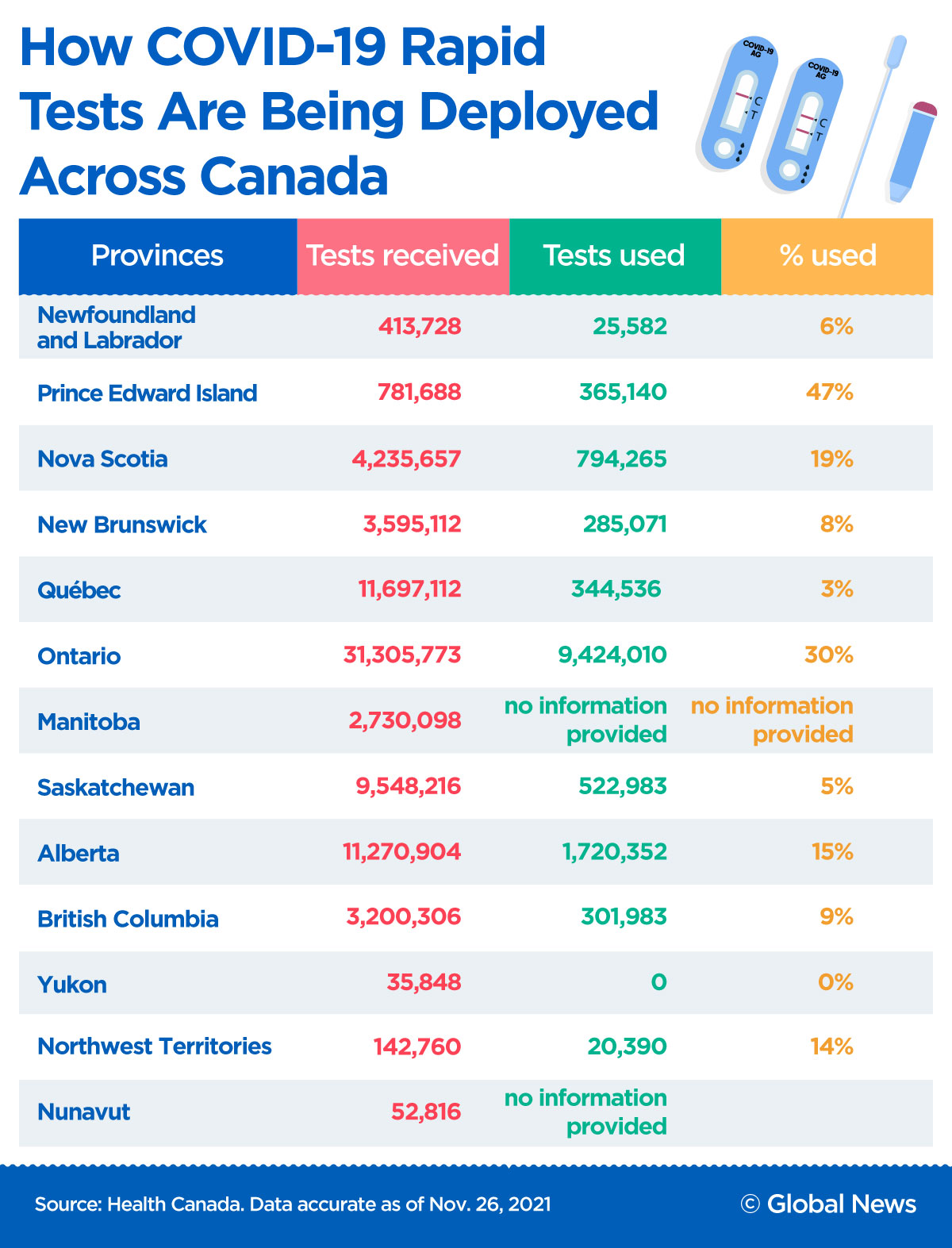With COVID-19 cases spiking across the country, and people preparing for indoor holiday celebrations, provincial governments are facing mounting pressure to make rapid tests more widely available.

Health Canada data shows the federal government has sent nearly 80-million rapid antigen tests to the provinces and territories, but just over 14.7 million were used as of Nov. 26.
Medical experts across the country have been calling on health officials to make the tests more accessible by making them free of charge, and more easily found at places like grocery checkouts — even gas stations.
READ MORE: B.C. government faces questions about lack of access to rapid COVID-19 tests

Canada’s rapid testing strategy has generally focused on long-term care homes, schools, and workplaces. Some provinces have limited the general public and people who are asymptomatic from accessing the tests.
With infection rates heading in the wrong direction in most jurisdictions, experts say expanding rapid testing is “critical.”
The Health Canada data shows that while the federal government has purchased more than 94.6 million rapid tests, just under 15 million have used, or roughly 16 per cent.
The antigen tests that typically use a shallow nasal swab are less reliable than the polymerase chain reaction (PCR) test but can offer results in less than 15 minutes. They can be used right before a family gathering or large public events to help control transmission.
“Rapid tests are a really good public health tool to reduce transmission of COVID 19 to keep society open,” said Dr. Amit Arya, a palliative care physician who works in the Greater Toronto Area. “This is something that we should be providing, ideally, to every household.”

Get weekly health news
Dr. Arya said rapid testing adds another important layer of defence in the fight against COVID-19, along with measures like vaccination, ventilation and masking.
“Many of us will be getting together with our loved ones during the holidays and can still be asymptomatic and transmit COVID 19,” he said, “Rapid antigen tests put the power in your hands, where you can test yourself at home before leaving for any of these settings.”
Part of the problem with Canada’s rapid testing strategy, experts and critics say, is that access to the tests differs widely depending on where you live in Canada. The tests can also be expensive, costing $40 in Ontario, a barrier for low-income families, according to Dr. Arya.
B.C. and Ontario, for example, have prioritized certain locations like businesses, essential workplaces, hospitals, and long-term care homes for rapid testing. Rapid tests can also be accessed at some pharmacies in Ontario, Alberta, Manitoba, and Saskatchewan.
In Quebec and Alberta, families with kids in elementary school can get rapid tests in the event of an outbreak or a child showing COVID-19 symptoms.
Other provinces like Nova Scotia, New Brunswick, Saskatchewan, and P.E.I have made the tests more widely available at testing sites, town offices, libraries, or to households with kids who are too young to be vaccinated.
Bogoch said it’s not just about access. Governments have to do a better job of communicating how to use the tests and integrate them into routine settings.
“If we had fewer barriers and greater accessibility, I think we would put them to good use,” he said. “It would be an important piece of a much larger puzzle to keep this pandemic under control in Canada.”
Experts said Canada should be following the lead of other countries such as Germany or the U.K. where tests are ubiquitous, cheap, in some cases free, and have become part of everyday life to help identify potentially infectious people before they can join crowds at a concert or dine-in at restaurants.
Rapid antigen testing was first approved just over a year ago in Canada but uptake has been slow. Petitions have sprung up in B.C. and Ontario calling for rapid tests to be placed in as many hands as possible.
READ MORE: Online petition urges Ontario government to provide free rapid antigen testing
An Ontario doctor has taken the step of creating a Twitter account to help people find rapid tests, similar to the widely successful Twitter accounts set up by vaccine hunters who helped people find vaccine appointments.
Dr. Dalia Hasan, who started the ‘COVID Test Finders’ account about three months ago, is among the voices calling on health officials to #FreeTheRATs, an acronym for rapid antigen tests.
“We’re currently woefully underutilizing testing,” said Dr. Hasan. “Not taking advantage of this critical public health tool is quite frankly an unforced error.”
Ontario Premier Doug Ford pushed back against criticism of his government’s rollout of rapid testing, saying that Ontario has handed out more rapid tests than all other provinces combined. Federal data shows that Ontario has distributed over 33 million tests, with a roughly 30 per cent usage rate — among the highest in Canada.
“We’re putting pop-up locations in malls and shopping centres and transit locations and workplaces to make sure it’s convenient to get tested,” Ford said during Thursday’s Question Period.
Ford also reiterated a promise to provide another 11 million rapid tests for schools — enough to send home five with every student before the holidays.
Meanwhile, Federal Health Minister Jean-Yves Duclos told reporters on Wednesday that provinces and territories should get ready to deploy more of the tests.
“We are very soon going to deliver to provinces and territories a very large amount of rapid tests, much larger than what we’ve seen over the last few months,” he said. “The demand from provinces and territories has been substantially increased over the last weeks and we hope to announce some very good news on that very soon.”
Asked Thursday about whether the tests should be free, Duclos said it’s up to his provincial counterparts to make that decision.
“Obviously we can’t decide what provinces will do with those tests, but the federal government is sending those tests for free,” he said.
—With a file from Caryn Lieberman













Comments